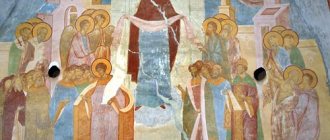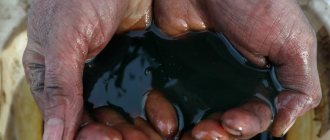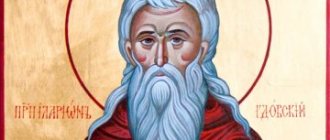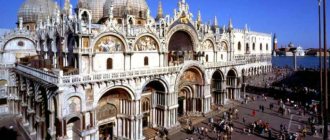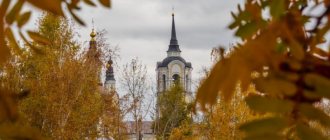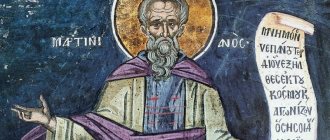On June 9, the Russian Orthodox Church celebrates the day of remembrance of St. Ferapont of Belozersky (Mozhaisk), revered by the church as a miracle worker. From this article you will learn what Feropont became famous for, why do people come to its source for healing these days? I will also name the main prohibitions for Orthodox Christians that cannot be violated today. At the end, you can read a prayer to Feropont Belozersky for support and deliverance from disasters.
The life story of Ferapont Belozersky (Mozhaisky)
In 1337, in Volokolamsk, in the noble land of the Poskochins, a boy, Theodore, was born. We know him as the Monk Ferapont, the Wonderworker of Luzhetsk. From an early age, Theodore showed a tendency towards a pious life and monasticism. He was not taught to read and write, but had a kind heart, a sound mind and had pure thoughts, thereby defending his piety.
When Theodore was about forty years old, never experienced, he took monastic vows. During his tonsure, Theodore received a new name - Ferapont. At the monastery, Ferapont made a good friend, the Venerable Kirill of Belozersky. One day Ferapont was sent on monastic affairs to the northern part of the Belozersk country. There he instantly fell in love with the desert territories and decided to leave the Simonov Monastery and go to Beloozero. At this time, the Virgin Mary appeared to St. Cyril and gave him the command to go north and build a monastery there. Ferapont and Cyril received permission from the abbot and, with blessing, set off on their journey to Beloozero, where they founded a monastery.
Ferapont never put himself above others and in addition to conducting services, he worked hard. The monks, inspired by the actions of Ferapont, also engaged in construction and repairs, decorating the monastery, rewriting books and tending vegetable gardens. The monk was offered to become abbot, but he refused and transferred the abbess to his student. The monks went to Ferapont for wise advice, but he himself, without shame, went to talk to his friend. Kirill Beloozersky helped his friend with advice and benefited him. But all the same, Ferapont remained a father and abbot for the rest of the monks. There were always monks in his cell who came for advice.
The Monk Ferapont wrote the rules of the monastery, and no one dared to disobey him. In every cell there should have been nothing but icons, Orthodox books and handicrafts. Complete silence was to be observed in the refectory room and the temple.
In those days, the lands on which the Ferapont monastery was located belonged to Andrei Dimitrievich, the son of Grand Duke Dmitry Donskoy. The prince had long wanted to build a monastery near Mozhaisk, and he allocated a lot of funds for the construction of the monastery. Soon, not far from Mozhaisk, in the city of Luzhki, the second monastery of Feropont was erected. In memory of the Beloozersky Monastery, the monk built a temple in honor of the Nativity of the Blessed Virgin Mary. The pious prince gratefully donated funds to the new monastery, but without forgetting about the old one, where huge amounts of money were also sent. Not wanting to place his monastery above others, Andrei Dimitrievich appointed Ferapont as abbot and gave him the rank of archimandrite.
The monk lived in the new monastery for 18 years and died in old age on June 9, 1426. He was buried near the Church of the Nativity of the Virgin. After his death, people began to venerate him almost immediately. In 1514, his holy and incorruptible relics were found, and soon he was canonized (1547). On the days of veneration, June 9 and January 9, people ask for a good harvest, for travelers and sailors. They also ask for protection from fire, flood and other disasters.
Two monasteries of St. Ferapont
In the Luzhetsky Ferapont Monastery of Mozhaisk there are the relics of the revered Russian saint - St. Ferapont of Belozersky. The ancient monastery stands in a picturesque place near a bend of the Moscow River on the northern outskirts of the city. In the village of Isavitsy, adjacent to the monastery, there is a holy well, which, according to church tradition, was dug by the monk in 1408.
Church history connects two dissimilar and distant regions of our country: the Russian north and the western part of the Moscow region. From the famous Belozersky Ferapontov Monastery in the Vologda region, threads stretch to the cities of Volokolamsk, Istra and Mozhaisk near Moscow. The Monk Ferapont, a native of Volokolamsk, founded the Belozersky Ferapont Monastery in the northern regions in the 15th century, and at the end of his life he founded another monastery, but in Mozhaisk near Moscow. Here to this day there is a tomb with the relics of the founder of two very different “Ferapont” monasteries: Luzhetsky monastery near Moscow and Belozersky monastery in Vologda.
In the 17th century, another thread stretched between Belozersk land and the Moscow region. Tsar Alexei Mikhailovich exiled the disgraced Patriarch Nikon, a church reformer, as well as the creator of the famous New Jerusalem near Moscow, to the northern Ferapontov monastery. The years of Nikon's stay in the Belozersk land became a period of unexpected growth of the fading remote monastery. Nikon, like the Monk Ferapont, was destined to find his final refuge near Moscow, and not in the north. The new Tsar Fyodor Alekseevich, having ascended the throne after his father, pardoned the former patriarch and allowed him to return to his beloved Resurrection New Jerusalem Monastery in Istra. Unfortunately, Nikon died on the way from exile, but his body was taken to New Jerusalem.
At the instigation of the traveler and writer of the first half of the 19th century, Andrei Nikolaevich Muravyov, the name “Northern Thebaid” was assigned to the Belozersk side. The ancient Thebaid is a desert region in Egypt surrounding Thebes. In these lands in the first centuries of Christianity, many hermits and hermits settled. The Russian north was radically different from the African deserts in climate and landscape, but was close to them in spirit, becoming a place that attracted monks. It turns out that Patriarch Nikon from his New Jerusalem, which imitated the Middle Eastern shrines of Palestine, was exiled to the “New Thebaid,” which became the symbolic successor to the land of the most ancient Christian monastic communities.
Saint Ferapont, in the world Feodor Poskochin, first settled in the Simonov Monastery near Moscow. The abbot of this monastery often sent the monk on various assignments to different cities and monasteries. One day Ferapont had the opportunity to travel to the distant Belozersk country - an endless desert consisting of forests, swamps and lakes. The harsh beauty of the wild nature made an indelible impression on the monk. Upon returning from a long trip, Ferapont found a like-minded monk Kirill, with whom he left the Simonov Monastery and went north. The monks founded two monasteries there: Kirillov-Belozersky, and then Ferapontov-Belozersky.
The Belozersk land, despite its remoteness from Moscow, was still dependent on the Moscow Grand Duke at the end of the 14th century. Dmitry Donskoy in his will gave Belozersk as an inheritance to his third son Andrey, whose “capital” was the city of Mozhaisk. During the internecine struggle between the heirs of Dmitry Donskoy for the grand ducal throne, Andrei was a loyal ally of his elder brother Vasily and his son Vasily Vasilyevich the Dark. The other side in this battle, which lasted a quarter of a century, was the ambitious Prince Yuri Zvenigorodsky, the second son of Dmitry Donskoy.
Kirill and Ferapont began their life in the Belozersk land with a hut and a dugout among the swamps, but over time, two monasteries grew here, the fame of which spread throughout many cities. The deputy of the Mozhaisk prince in Belozersk personally met with the hermit Ferapont and then recounted his impressions to Andrei Dmitrievich. Having heard about a new ascetic in his inheritance, the prince wanted to have such a prayer book closer to himself. Andrei begged Ferapont to come to Mozhaisk for a conversation, and upon the elder’s arrival, he did not let him go back to the north. The prince insisted that the saint found a new monastery. This is how the Ferapontov Monastery appeared near Mozhaisk, called Luzhetsky because of its location near the meadows of the Moscow River.
During the Soviet years, a football field was built next to the monastery, so local residents often call the Luzhetsk monastery “the monastery near the stadium.” The monastery has three churches: the main five-domed Cathedral of the Nativity of the Mother of God, where the relics of St. Ferapont rest, the cubic gateway Church of the Transfiguration of the Savior, as well as the Church of the Entry of the Virgin Mary, which is crowned by a small blue dome without a cross. Among other surviving buildings, a separate hipped bell tower is interesting, in the lower tier of which there is a tomb of the Savelov family.
Four hundred meters from the walls of the monastery in the village of Isavitsa there flows a holy spring, which, according to legend, was dug by the Monk Ferapont himself in 1408. This well was filled in during the Soviet years, but today it has been restored. The spring of St. Ferapont is well maintained. Here there are good-quality new log houses of the chapel and baths, a belfry, an interesting mosaic icon of the saint and church shops. The territory of the spring is decorated with pleasant landscape design. The Luzhetsky Monastery itself, in contrast to the source, leaves the impression of some neglect, although leisurely restoration work is underway. Nevertheless, the somewhat dilapidated walls of the monastery, perhaps, better convey the spirit of deep antiquity than the well-appointed, but emphatically “renovated” space of the monastery source.
The healing spring of Feraponta near Mozhaisk
If you go near Mozhaisk to the Luzhetsky Monastery, then do not forget to stop by the holy spring of Ferapont, located very close to those places, literally on the next street, if you go down from the monastery to the river. According to legend, the source was dug by Ferapont himself in 1408 when he founded the Luzhetsky Monastery. Even during the life of the Saint himself, people from all over Rus' came to the monastery for help and were also healed by this miraculous water. In 1981, Moscow merchant Ivan Rybnikov received healing from his illness here and, in gratitude, erected a chapel on this site and equipped a well. During Soviet times, the spring, like the monastery, was abandoned. Now everything is equipped and very well maintained. On the territory there is a chapel, a font, a church shop with delicious pies...
Venerable Ferapont of Monza. Icons
The Monk Ferapont of Monza is traditionally depicted on icons in monastic vestments, with a blessing right hand.
Venerable Ferapont of Monza. Galich, first quarter of the 18th century. From the Church of the Intercession with. Pemy, Galichsky district, Kostroma region. Since 1964 at KGOIAMZ "Ipatiev Monastery"
Venerable Ferapont of Monza. Fresco of the Trinity Cathedral of the Trinity-Sypanov Pachomiev-Nerekhta Convent, Kostroma Region
What not to do on June 9, the day of remembrance of Ferapont Belozersky
- Do not engage in heavy physical work. Only light work is allowed, including cooking and washing dishes. But it’s better not to use a broom - you can sweep away everything good that is in the house.
- Don't quarrel with loved ones, don't argue and avoid talking in a raised voice. Even minor quarrels and conflicts on this day can cause a big scandal that will spoil your relationships with people.
- Don’t be sad and don’t indulge in sad memories, but don’t have too much fun, especially with alcoholic drinks. On this day it is important to know when to stop. Including in food.
- Do not refuse mercy and help to those who turn to you for them. Especially the poor and homeless.
- On June 9, it is advisable to avoid empty chatter and gossip. It is better to devote this day to prayer and spiritual development.
Prayers
Troparion, tone 4
Having been enlightened by your pure life,/ in the prayers and fasting of the desert, you appeared in good vegetation/ and, following your spiritual teacher,/ directed your mind towards heavenly,/ you were a mentor to your flock,/ so we pray to you, Father Feraponte:/ pray to Christ God to be saved to our souls
.
Kontakion, tone 4
Our all-good Savior Christ increased His mercy to us, giving us as a protector and healer, our reverend father Ferapont, who enlightens us with the image of his holy life, and now with his prayers he protects his monastery from enemies and destruction, this country from famine and vain deaths , who honor his memory from all illnesses and fierce passions
.
What can you do today June 9
- Pray to Saint Ferapont for success in business, for a large harvest, for protection from floods and fires and other disasters. A very powerful prayer for those who will ask for travelers, warriors (those in the army) and sailors.
- Give alms to those in need. It doesn't have to be money. Things, clothes, physical help, or even just a kind word - all the good things you do today will come back to you doubly later.
If you spend this day correctly, then the Monk Ferapont of Belozersky will definitely hear all your requests and will soon fulfill them.
Troparion and Kontakion to St. Ferapont of Monza
Troparion, tone 8.
ABOUT! you, Father Feraponte, know the speed of salvation. Let us accept the cross, for you followed Christ. But whoever does and learns to despise the flesh passes away, but to practice things more immortal for the soul. In the same way the angels rejoice, O venerable spirit.
Kontakion, tone 2.
Divinely armed with purity of soul, and unceasing prayer, as if firmly handing over a copy, you prosecuted the demonic militia of Feraponte, Our Father, pray unceasingly for all of us.
